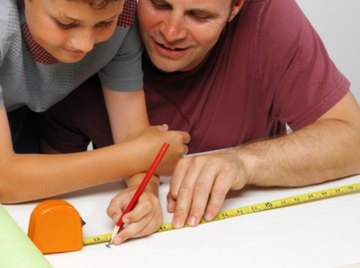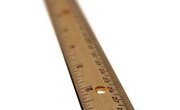
Measurements are part of our daily lives. We measure food ingredients, time, objects and space. Kids learn math and measurement skills before they learn those words. Teach kids, whether at home or in a classroom, the different types of measurements they need to know and the tools they can use to measure certain things. Help them remember measurement terms and conversions, and provide plenty of hands-on activities to experience all types of measurements. The National Council of Teachers of Mathematics suggests expectations for children beginning at preschool age, so parents and teachers can provide appropriate learning experiences to the different age groups.
Pre-Measurement Activities
Help young children learn measurements in length and size. Ask them to differentiate objects by choosing between small and large (or big and little), tall or long and short, thick (or fat) and thin. Gradually add items to help them learn shortest to tallest, smallest to biggest and so on.
Instill understanding of volume. Have the children tell you when their glass is half-full or when the milk carton is empty. Let them experience filling a crayon box full or deciding whether a clay container is full or empty without looking inside.
Introduce measurement of time. Stress the concept of time when it is "time" for circle activities, "time" to go outdoors, "time" for snack and "time" to go home.
Talk about the measurement of weight. Instruct two children to move a box of toys and one child to move a single toy.
Learn Basic Measurements
Teach the units of measurement to children. Post a chart or give each child a printout of measurements to read and learn.
Help children learn the concepts of inches, feet and yards. Have them recite volume measurements like how many ounces in a cup, cups in a pint, quarts in a gallon and dry ounces in a pound. Practice saying the measurements of time, as in how many minutes are in an hour or hours in a day.
Increase the learning of the units of measurement for older classes. Review the basics and then present more difficult concepts.
Use Measurement Tools
- Different-sized objects
- Drinking glass
- Empty milk carton
- Crayon box
- Clay container
- Box of toys
- Single toy
- Posters or printouts of measurement tables
- Rulers
- Yardsticks
- Tape measures
- Cups
- Variety of sizes of containers
- Liquid and dry ingredients
- Scale
- Clocks
Provide unit measuring tools according to your children's age level or current math lesson plans. Do some hands-on activities with each type of tool.
Have the children use rulers, yardsticks and measuring tapes. Encourage kids to measure the width or height of doors, windows and the room. Older children can use the same tools to figure the unit of area, such as square feet, for various items.
Provide cups, quart and larger containers for the kids to measure water or dry ingredients. Let them experiment with a scale as well, to learn the difference between liquid and dry ingredient measurements.
Use real or toy clocks for kids to practice measuring time. Give them some problems to solve such as how many hours and minutes they have been at school so far that day or a set of minutes adding up to how many hours.
Things You'll Need
References
About the Author
Larry Davis has worked in the safety and environmental field since 1975, writing for "Chevron Review" and other professional magazines. He wrote monthly columns for "Heavy Equipment News" and has written safety programs and training materials. He holds two bachelor's degrees, a master's degree in safety and earned his doctorate in safety engineering, studying under professors from the University of Iowa and Texas A&M University.
Photo Credits
Polka Dot Images/Polka Dot/Getty Images
